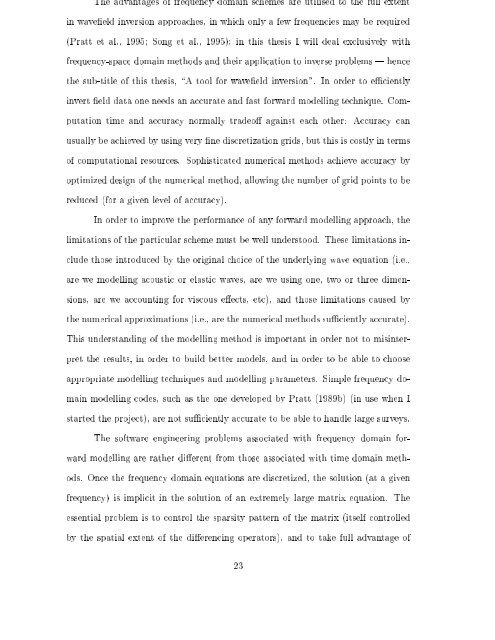Frequency domain seismic forward modelling: A tool for waveform ...
Frequency domain seismic forward modelling: A tool for waveform ...
Frequency domain seismic forward modelling: A tool for waveform ...
Create successful ePaper yourself
Turn your PDF publications into a flip-book with our unique Google optimized e-Paper software.
The advantages of frequency <strong>domain</strong> schemes are utilised to the full extent<br />
in waveeld inversion approaches, in which only a few frequencies may be required<br />
(Pratt et al., 1995; Song et al., 1995); in this thesis I will deal exclusively with<br />
frequency-space <strong>domain</strong> methods and their application to inverse problems | hence<br />
the sub-title of this thesis, \A <strong>tool</strong> <strong>for</strong> waveeld inversion". In order to eciently<br />
invert eld data one needs an accurate and fast <strong><strong>for</strong>ward</strong> <strong>modelling</strong> technique. Computation<br />
time and accuracy normally tradeo against each other: Accuracy can<br />
usually be achieved by using very ne discretization grids, but this is costly in terms<br />
of computational resources. Sophisticated numerical methods achieve accuracy by<br />
optimized design of the numerical method, allowing the number of grid points to be<br />
reduced (<strong>for</strong> a given level of accuracy).<br />
In order to improve the per<strong>for</strong>mance of any <strong><strong>for</strong>ward</strong> <strong>modelling</strong> approach, the<br />
limitations of the particular scheme must be well understood. These limitations include<br />
those introduced by the original choice of the underlying wave equation (i.e.,<br />
are we <strong>modelling</strong> acoustic or elastic waves, are we using one, two or three dimensions,<br />
are we accounting <strong>for</strong> viscous eects, etc), and those limitations caused by<br />
the numerical approximations (i.e., are the numerical methods suciently accurate).<br />
This understanding of the <strong>modelling</strong> method is important in order not to misinterpret<br />
the results, in order to build better models, and in order to be able to choose<br />
appropriate <strong>modelling</strong> techniques and <strong>modelling</strong> parameters. Simple frequency <strong>domain</strong><br />
<strong>modelling</strong> codes, such as the one developed by Pratt (1989b) (in use when I<br />
started the project), are not suciently accurate to be able to handle large surveys.<br />
The software engineering problems associated with frequency <strong>domain</strong> <strong><strong>for</strong>ward</strong><br />
<strong>modelling</strong> are rather dierent from those associated with time <strong>domain</strong> methods.<br />
Once the frequency <strong>domain</strong> equations are discretized, the solution (at a given<br />
frequency) is implicit in the solution of an extremely large matrix equation. The<br />
essential problem is to control the sparsity pattern of the matrix (itself controlled<br />
by the spatial extent of the dierencing operators), and to take full advantage of<br />
23

















